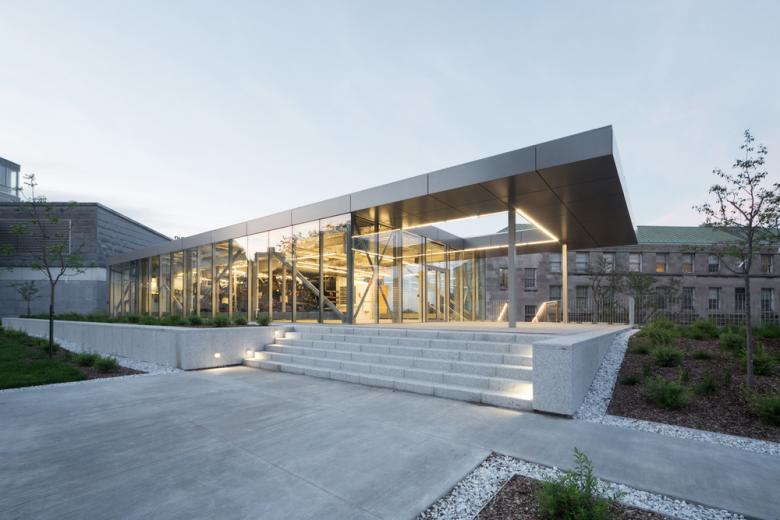McGill University Power Plant
Les architectes FABG
22. fevereiro 2021
Photo: Steve Montpetit (All images courtesy of v2com)
McGill University needed a new building to house three 1.5 MW emergency facilities, generators that will protect research activities in the event of a power outage.
Location: 840 Avenue du Docteur-Penfield, Montreal, QC, Canada
Client: McGill University
Architect: Les architectes FABG (Eric Gauthier, Marc Paradis)
Project Manager: Johanne Guertain, GPH
Assistant Project Manager: Nadia Nachtigall, McGill University
Structural Engineer: Ayad Bensbaa, CIMA+
Civil Engineer: Guillaume Harpin, CIMA+
Mechanical/Electrical Engineer: Guillaume Bouccara, Alain Bilodeau, BPA
Landscape Architect: Ziad Haddad, WAA
General Contractor: Benoit Fiset, David Morissette, Mathieu Mainville, QMD
Photo: Steve Montpetit
The McGill University thermal power plant and the Wong, Rutherford, Administration, and Leacock pavilions are powered by a single emergency generator located in the Ferrier building in the immediate vicinity of the boiler room. This presents risks that should be limited by Housing New generators in separate spaces in the immediate vicinity.
The feasibility studies compared several location hypotheses, which led to the location of the structure between the Ferrier building (1963) and the Wong Pavilion (1990) being the best location. These preliminary studies also described the functional parameters associated with the two required 1.5 MW generators and the possible addition of a third in the future.
Photo: FABG
InnovationThe project was developed as part of a multidisciplinary integrated design exercise combining historical research, architecture, engineering, landscape, and urban acoustics to formulate a sensitive response to a problem that cannot be limited to utilitarian considerations.
The steeply pitched lot was an unused parking lot on Dr. Penfield avenue, which supported a greenhouse that had been demolished. It faces the castle-style pumping station of the McTavish underground reservoir and is part of the Mount Royal historic and natural District protected area.
Photo: Steve Montpetit
The proposed concept is based on the following objectives:
- Preserve transparency and permeability at Dr. Penfield level
- Establish an additional link between the top and bottom of the campus
- Structure the slope left in the wasteland
- Ensure a significant plant presence on the site
- Strengthen the specific character of McGill by using Trenton limestones
- Promote integration by respecting existing alignments and templates
The solution chosen is a glass pavilion on a limestone podium in alignment with the facades adjacent to the location of the disappeared greenhouses. A gazebo, under the extension of the roof, separates it from the Ferrier building and an external staircase leads to the lower level of the campus. Under this pavilion, a ventilation plenum allows the entry through the floor of the large amount of new air required while concealing the steam pipes connecting the Wong pavilion to the Ferrier Pavilion. The cantilevered overhang at the rear has vent grilles at the underside of the floor.
Photo: Steve Montpetit
The roofs are vegetated due to the low height of the building which exposes these surfaces to the view all over the south flank of Mount Royal and from surrounding buildings. For the roof surfaces and walls covered with metal panels, environmental problems related to lead discouraged us from using the tinned copper present on the Wong building and led us to propose a fluoropolymer paint baked on an aluminum panel to harmonize with the shade of the neighbor. The acrylic coating on the adjacent portion of the Ironworks has been replaced with limestone siding in this project.
The project focuses on the underlying presence of the mountain by dramatizing the topography of the site. Although it is a technical infrastructure, we insisted on treating the building as a pavilion that could help enhance the quality and specificity of the McGill University campus.
Photo: Steve Montpetit
ProgramStorage and maintenance spaces for campus furniture and outdoor amenities are laid out at the foot of the slope and the limestone-clad main wall becomes parallel to the rest of the campus. A mature Elm is preserved at the foot of the staircase, which extends the existing sidewalks to University Street to enrich the network of pedestrian traffic that is being consolidated throughout McGill.
The generators are installed in a glass pavilion sitting on a granite baseboard at Dr. Penfield Street level while there is storage space for campus street furniture on the lower level. The interstitial space between these two volumes serves as a plenum for air, steam, and electricity connected to the Ferrier power station. An open staircase opens a new passage along the east-west axis to connect the top and bottom of the campus.
Drawing: FABG
Drawing: FABG
Drawing: FABG
Drawing: FABG
Drawing: FABG
Artigos relacionados
-
McGill University Power Plant
on 22/02/2021










